Ever thought about transforming your outdoor space with pallet wood? Discover the secrets to properly treating pallet wood for long-lasting, stunning outdoor projects!
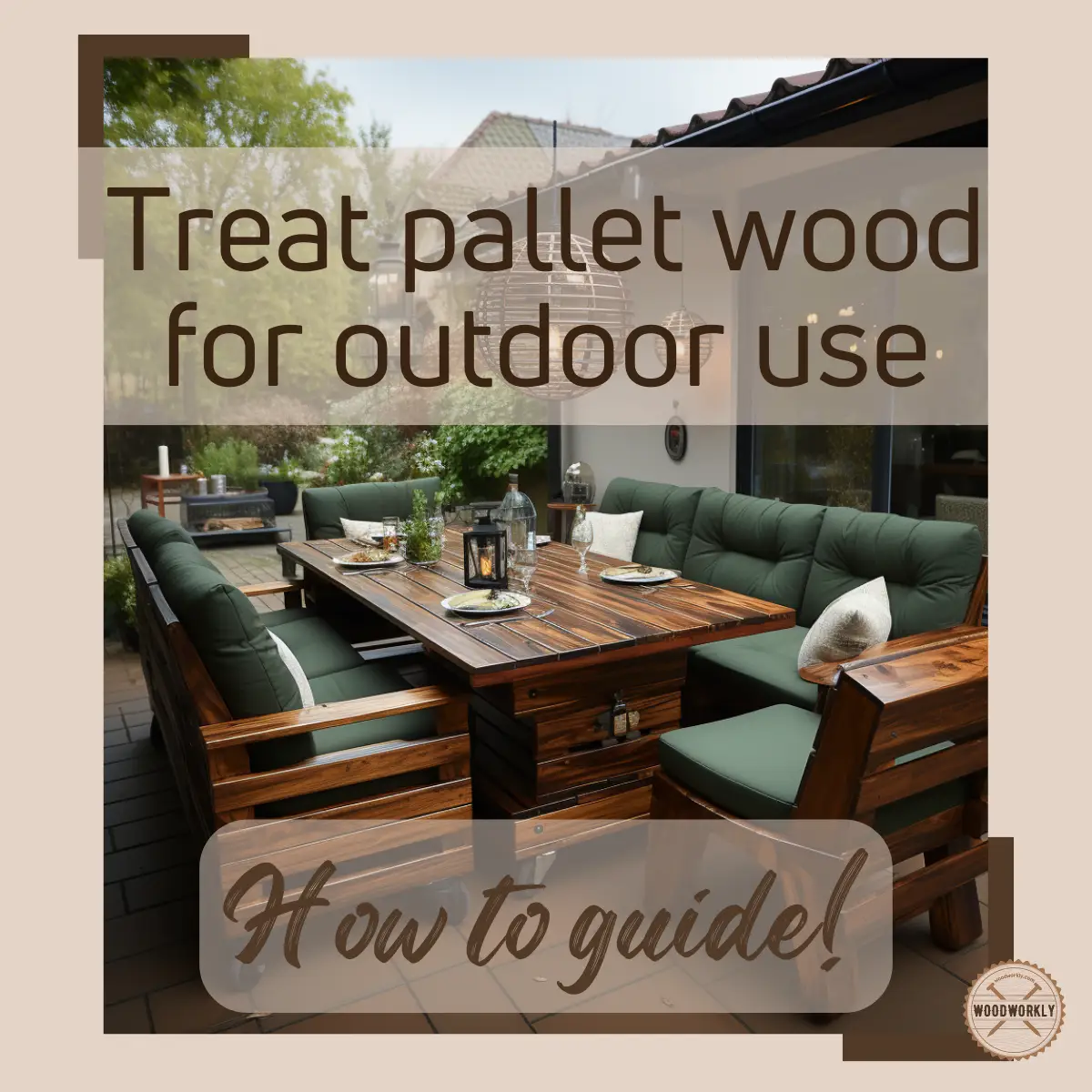
Pallets are generally inexpensive, and it is possible to persuade providers to give extra pallets for free. They can be repurposed as bookshelves, coffee tables, chairs, planters, and much more.
Concerning outdoor usage, I became interested in waterproofing wood pallets to shield them from the elements.

In 2008, I conducted extensive research on how to treat my wood pallets before placing them outdoors, seeking advice from experts in my San Francisco area.
Over more than a decade, I applied these techniques, which significantly enhanced the durability of my wood pallets.
So, let’s discuss how to treat pallet wood for outdoor use?
To treat pallet wood for outdoor use, start by sanding the wood to remove any rough spots and debris. Next, apply a wood preservative to protect against rot and insect damage. Finally, finish by applying a waterproof sealant or exterior-grade varnish to protect the wood from moisture and UV damage. Ensure good ventilation and avoid direct ground contact to extend the wood’s lifespan.
But that’s a quick snapshot and there’s a lot more to know about treating pallet wood for outdoor use.
So, in this article, I’ll explore, how to treat pallet wood for outdoor use, things you can use to treat pallet wood, and more.
Furthermore, I’ll answer frequently asked questions as well.
Let’s jump in!
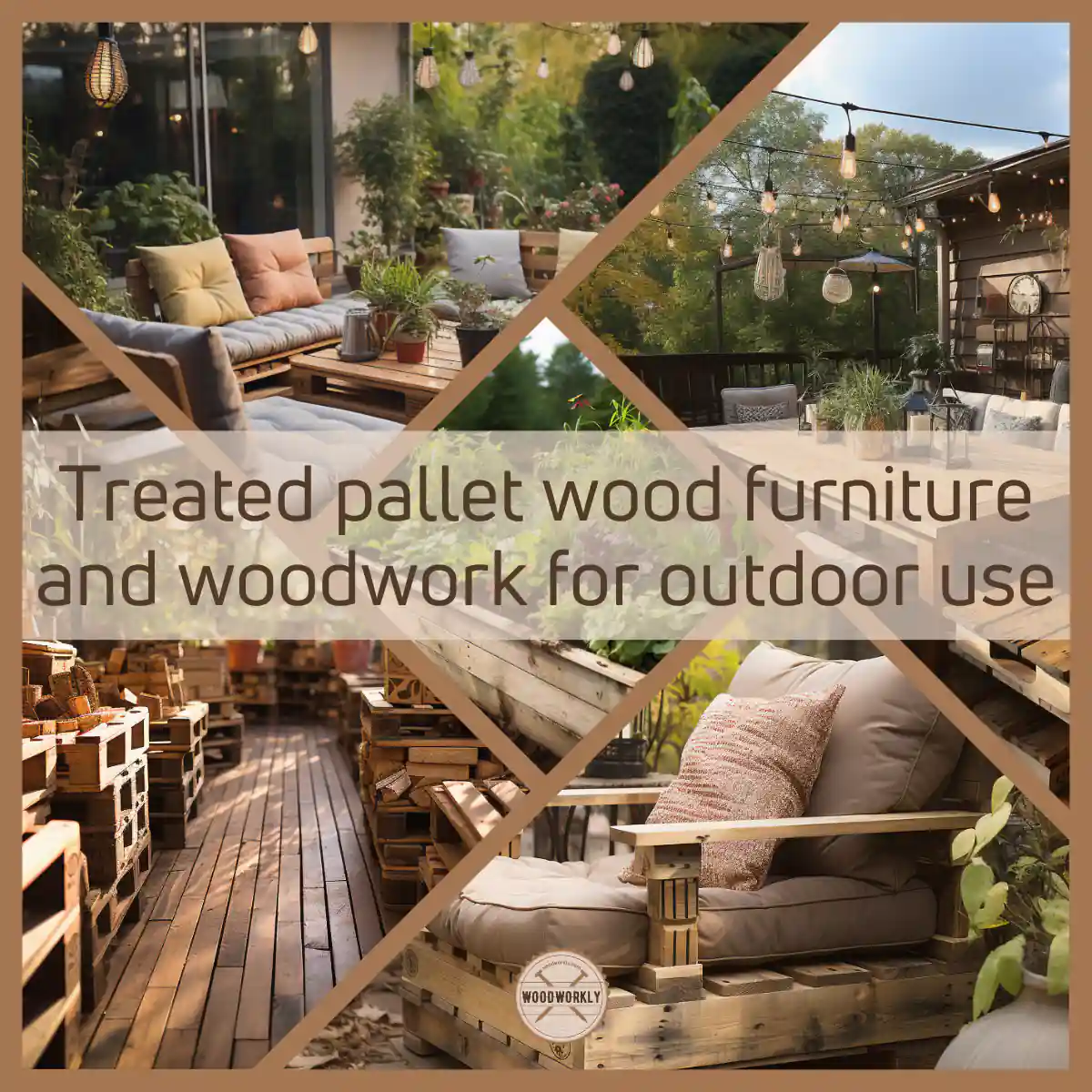
Why Treat Pallet Wood for Outdoor Use?
Treating pallet wood for outdoor use is important to prevent it from rotting and to protect the wood from environmental elements such as moisture, UV rays, and insect attacks.
By treating pallet woods you’ll be able to make them safe from bacteria, mold, chemicals, and other harmful substances.
Nowadays, pallet wood can be used literally for anything.
Chairs, planters, tables, bookshelves, porches, patio furniture, flower boxes, wooden fences, and many other woodwork and furniture can be made by using pallet wood.
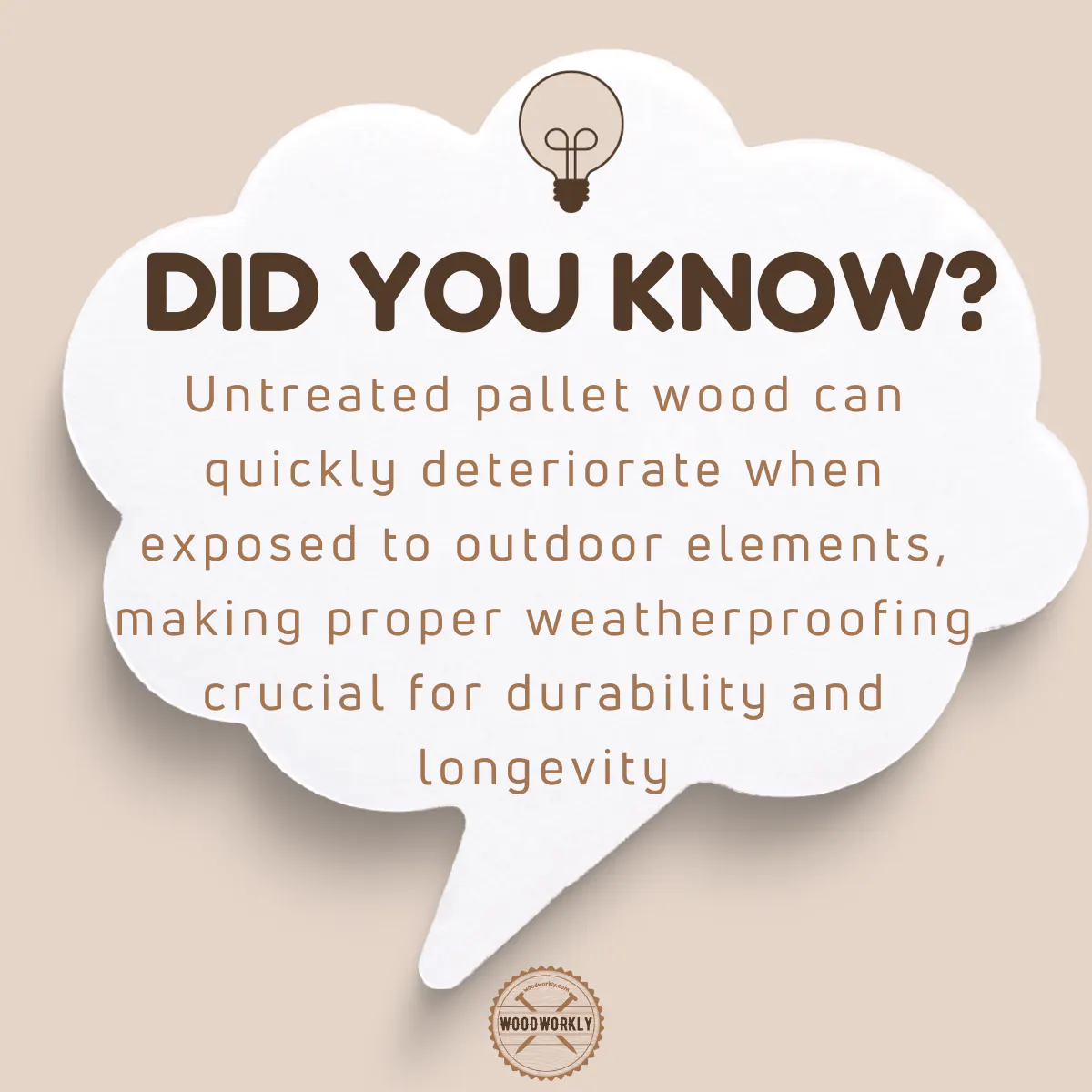
This is because they are affordable and easy to repair. To make them safe from environmental elements, you need to treat pallet wood properly.
Plus, you can increase the lifetime and durability of pallet wood by treating it.
Never leave pallet wood furniture or woodwork outdoors without treating it because the wood will begin to rot so quickly as soon as the moisture went inside of the wood through the fibers.
Once the wood starts to rot, it will have an unpleasant appearance. Restoration is also difficult if things get worse.
You’ll have to use special chemicals like flex seal to restore rotted pallet woods.
Therefore, better to take action by treating them before keeping them outside to avoid the woods from warping and damaging.
Plus, woods will discolor when they are exposed to sunlight for so long because of the harmful UV rays.
Treating helps to prevent wood discoloration and keeps them so long fresh as new.
Treating sealants and stain products have anti-UV agents that absorb UV light by preventing them from entering the wooden surface.
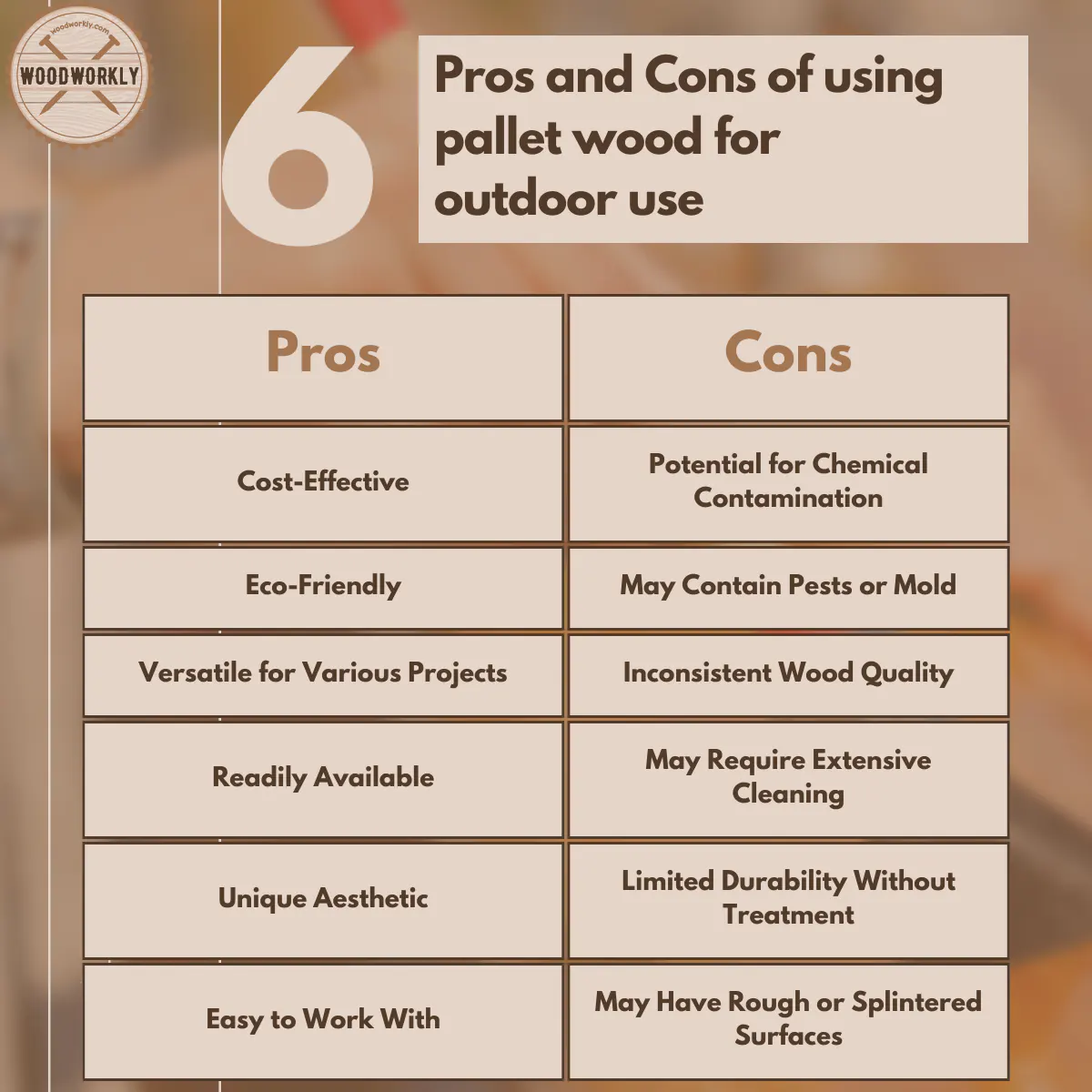
Treating protects wood from cracking and splitting upon temperature variations and humidity changes.
Sealing and staining tolerate environmental impacts on wood pallets and protect the wood while enhancing the wood’s appearance.
In summary, here’s why you should treat pallet wood for outdoor use,
- To prevent pallet wood from rotting
- Protect pallet wood from water damage
- Protect pallet wood from UV light
- Protect from insect attacks
- Protect from temperature variations
- Prevent wood discolorations
- Keep pallet wood from cracking and splitting
- To enhance the wood appearance
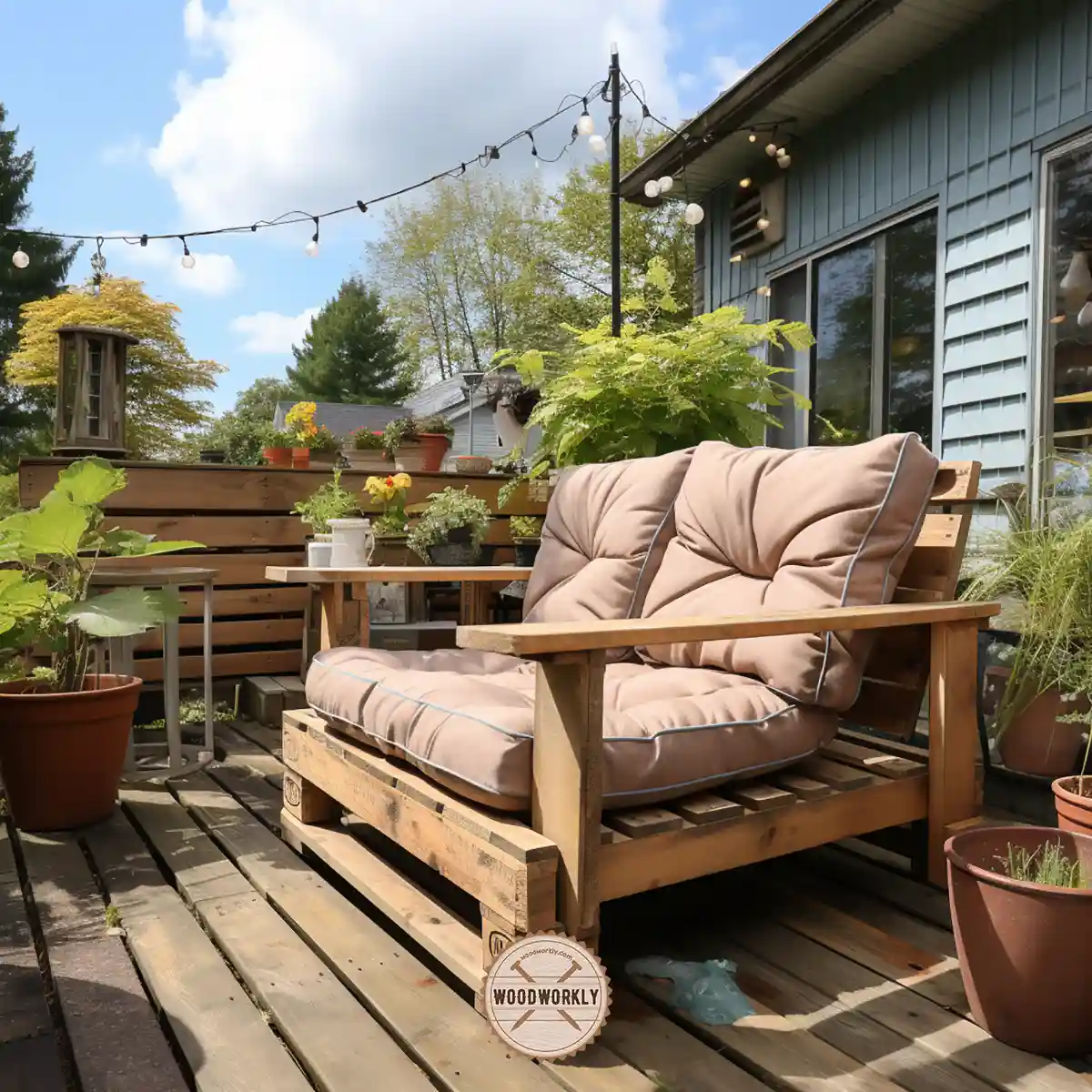
So, let’s find out what sealants and stain products you can use to treat pallet wood for outdoor use.
What Can You Use To Treat Pallet Wood For Outdoor Use?
You can use sealant or stain to treat pallet wood for outdoor use. Apply sealant or stain all over the pallet wood and let it dry before keeping it outside for best use.
Always read the manufacturer’s instructions before using any product on pallet wood to apply without making any mistakes.
Here are the best products you can use to treat pallet wood for outdoor use,
- Epoxy finish
- Oil finish (Tung oil, Linseed oil, Danish oil, Hemp oil)
- Paint
- Varnish
- Stain
All the above wood-treating products help pallet wood to get protected from environmental elements such as moisture, UV light, insect attacks, and more.
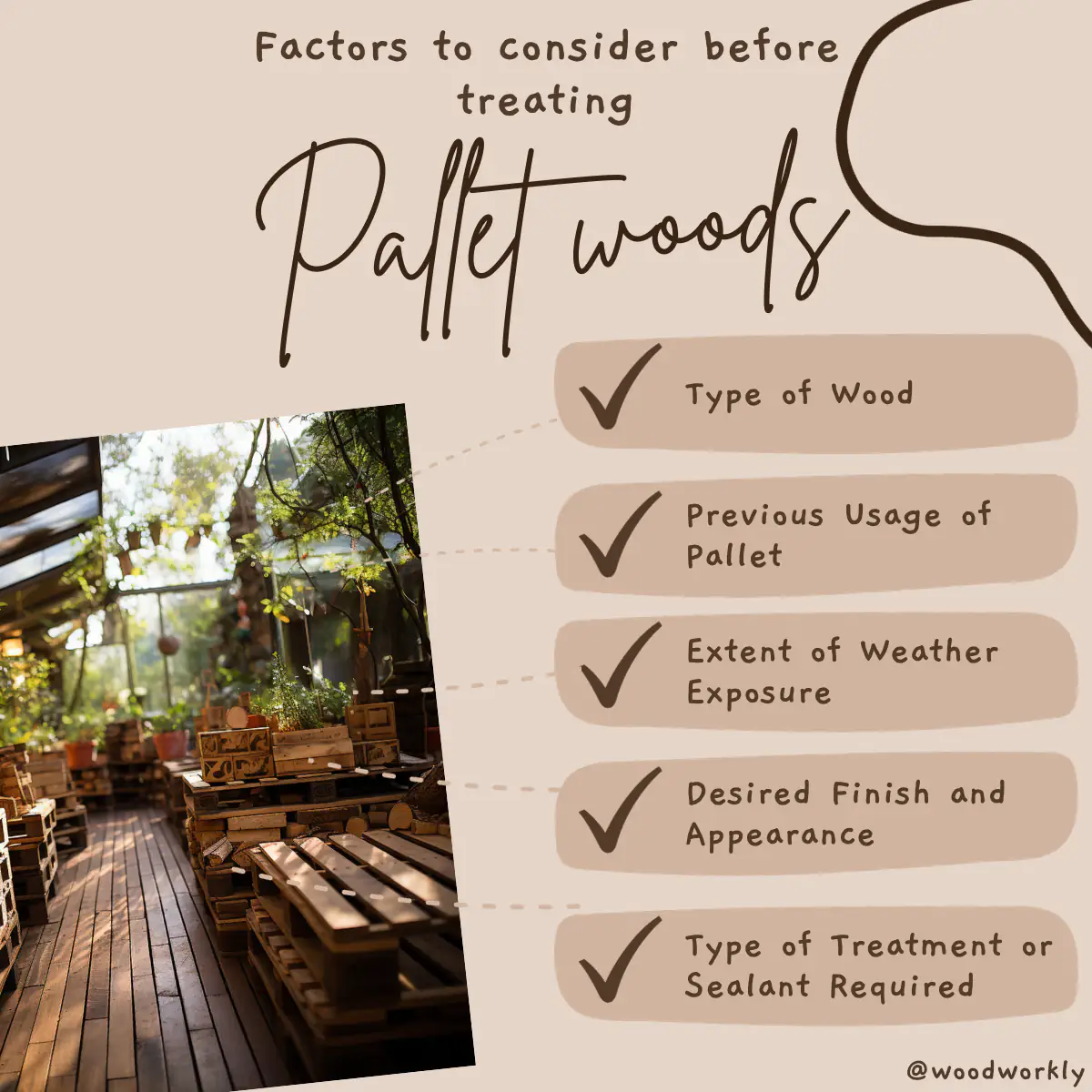
Best Methods to Treat Pallet Wood For Outdoor Use
So, let’s discuss each of the methods you can follow to keep your wood pallet outside safe without any effect from the elements.
Just keep reading!
1. Apply Epoxy Finish on Pallet Wood
The epoxy finish provides waterproofing ability to pallet wood and prevents pallet wood furniture and woodwork from water damage.
Epoxy finish is consisting of epoxy resin and hardener. Mix both resin and hardener well in a container before applying to the pallet wood.
After mixing pour and apply epoxy finish on an entire wooden surface without missing any spot. Use a bristle brush to apply on edges and tough corners.
Epoxy resin doesn’t give much protection from UV light. Therefore, if you are going to place pallet woods in an area that is exposed to direct sunlight, better not to use an epoxy finish.
A single coat of epoxy finish is enough to treat pallet wood for outdoor use.
Water particles cannot penetrate through the epoxy layer and damage the wood. epoxy finish protects wood from rotting.
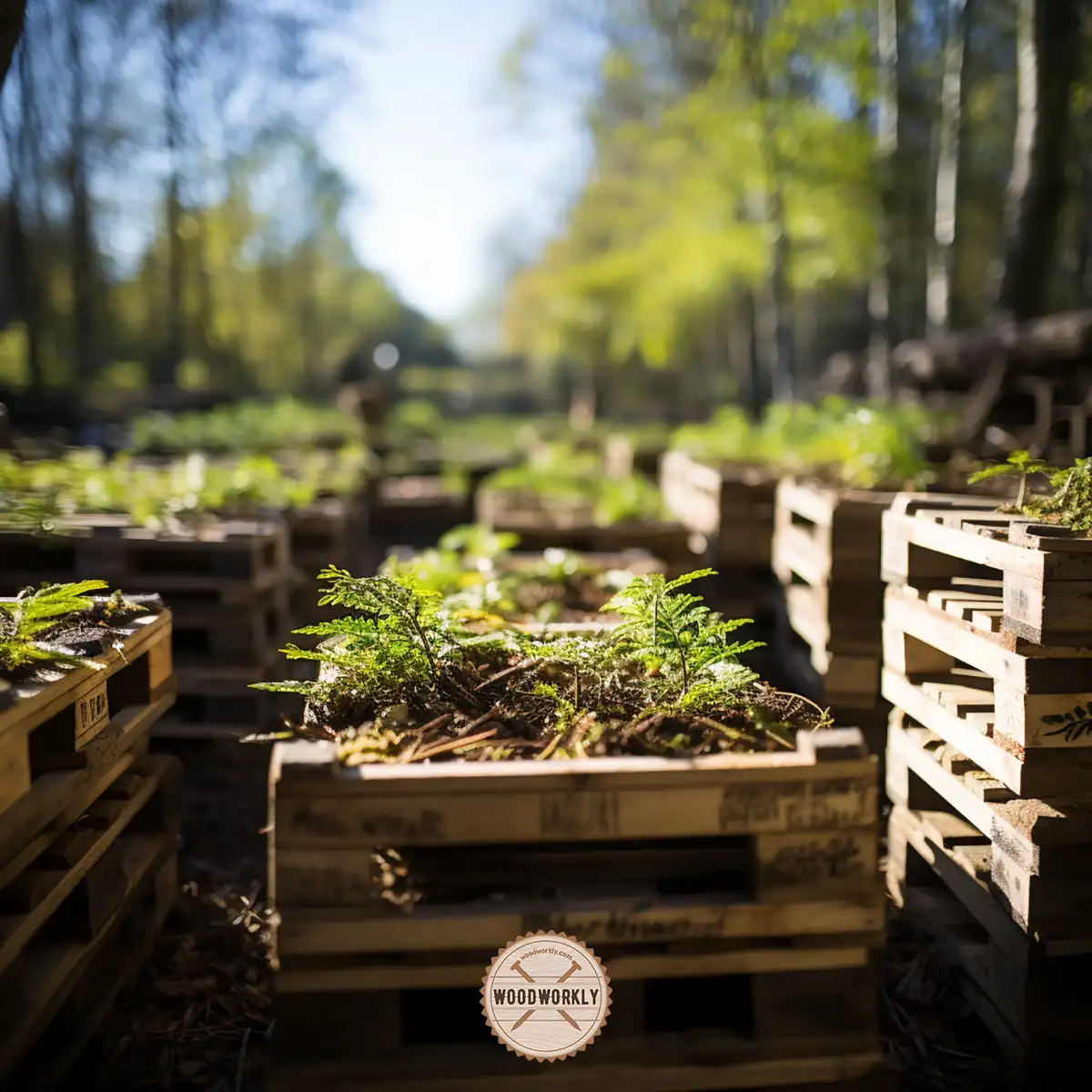
2. Apply Oil Finish on Pallet Wood
Oil finishes protect pallet wood from water damage and UV light. Oil finishes penetrate deep into wood fibers and protect them from outdoor environmental impacts.
Oil finishes harden upon exposure to the air and are able to produce a rich glowing look to pallet woods.
Plus, they protect the wood from cracking and peeling.
Here are some of the popular oil finishes you can use for treating pallet wood,
- Tung oil
- Linseed oil
- Danish oil
- Hemp oil
Curious how they work on pallet wood? let’s discuss each one of them.
Tung Oil
Tung oil is a natural wood finishing oil that provides a transparent, wet look to your pallet woods. Tung oil is waterproof and protects pallet wood from cracking.
Therefore, tung oil-treated pallet wood can be used outdoors.
Tung oil-treated pallet woods are able to tolerate environmental impacts because they repel moisture, are resistant to acids and alcohols, do not crack upon humidity variations, and have lots of benefits.
Tung oil finish is non-toxic, food safe, easy to apply, attractive in color, doesn’t yellow over time, and has excellent elasticity as well.
On the other hand, it takes a lot of time to dry, is expensive, and doesn’t smoothen the wood grain.
Overall, tung oil is one of the best oil finishes for pallet woods. Once tung oil is applied, you’ll be able to use pallet wood for any kind of woodworking project.
Linseed Oil
Linseed oil is an eco-friendly finishing oil that helps to hide dents and scratches of pallet wood and enhance the wood’s appearance while providing excellent protection from environmental elements like moisture.
Linseed oil finish is water resistant and prevents pallet wood from rotting due to moisture absorption.
It is easy to apply and can be used as a wood conditioner as well. Linseed oil is filled with lots of benefits over regular finishes.
Linseed oil is food-safe, non-toxic, and able to tolerate humidity variations due to high elasticity.
But linseed oil finish needs regular maintenance, and it yellows over time.
Therefore, linseed oil needs to be reapplied on pallet wood at least once per year.
Plus, it doesn’t provide UV resistance.
Therefore, never use linseed oil on pallet wood especially if your woods are exposed directly to the sunlight.
Linseed oil provides extra sheen and glossiness to pallet wood furniture or woodwork to increase the natural beauty and appearance.
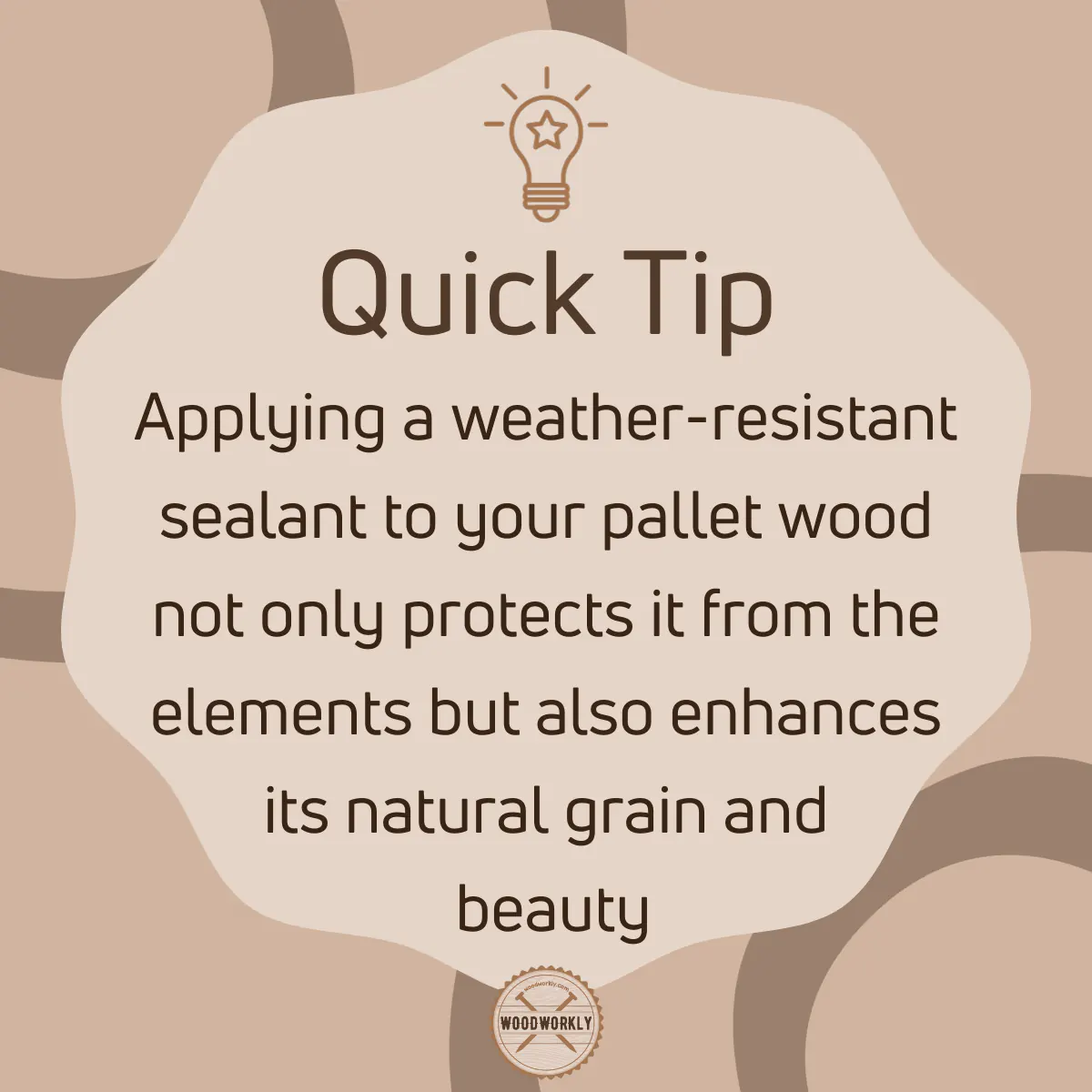
Danish Oil
Danish oil is one of the most popular finishing oils for pallet woods since it is a waterproofing oil that dries faster than other oil finishes.
Danish oil improves the sheen of pallet woods while providing excellent resistance against scratches and chemicals.
Danish oil is easy to apply, food safe, able to use as a primer, and repels water particles.
Therefore, Danish oil can be used to treat pallet wood for outdoor use because of its water resistivity.
But on the other hand, Danish oil needs regular maintenance and can be applied only on bare wood.
Therefore, make sure to sand the entire pallet wood surface before treating it with Danish oil.
Hemp Oil
Hemp oil protects pallet wood from UV light and water damage.
Plus, it will enhance the wood appearance and add a unique look to your pallet wood furniture and woodwork.
Hemp oil is an environmentally friendly oil that will last up to 2 -3 years with proper care.
Regular maintenance is needed to keep hemp oil finish as fresh as new and for better protection from environmental elements.
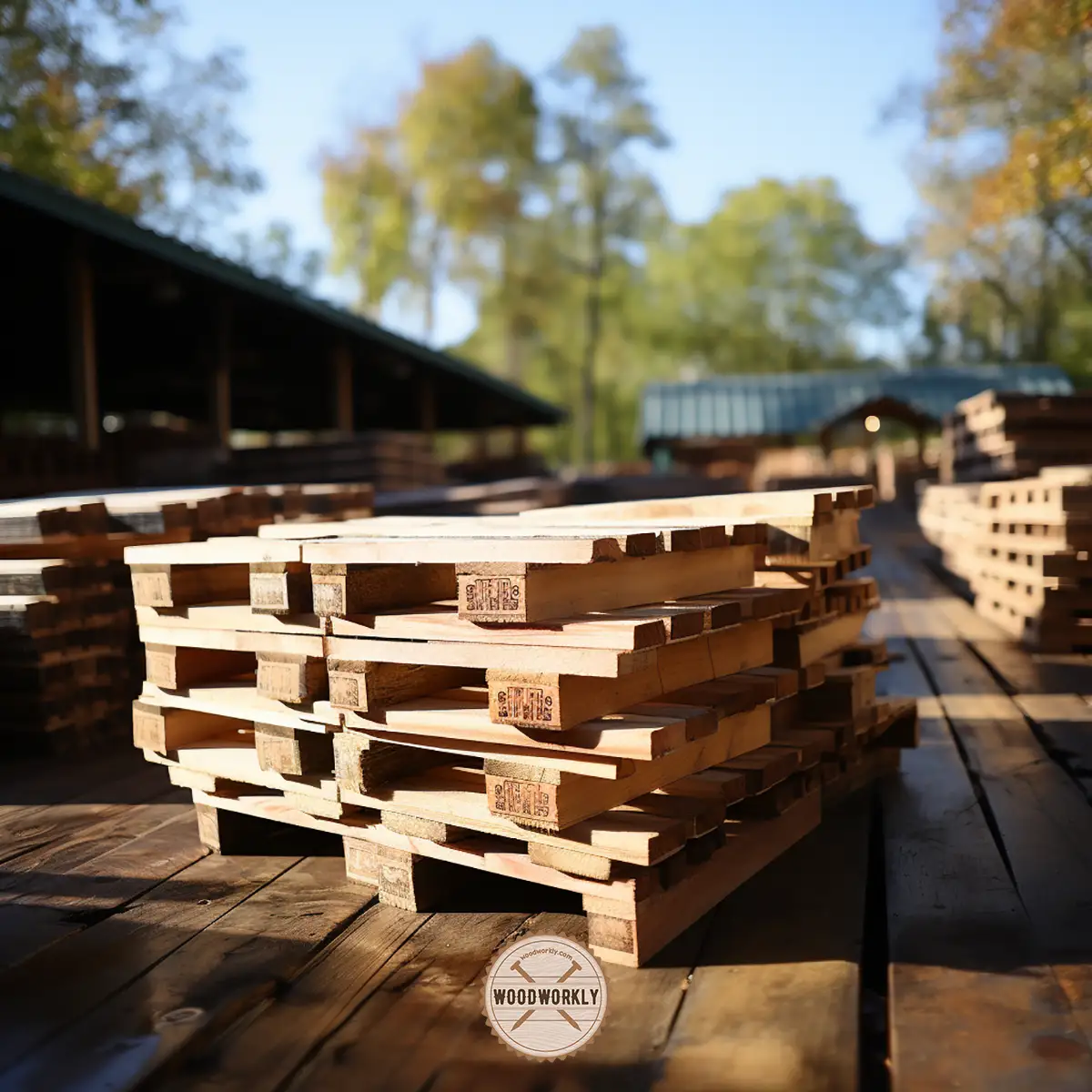
3. Painting Pallet Wood
Paint is an excellent treating product for pallet wood. Paint coatings protect pallet wood from moisture, UV light, scratches, cracks, and peelings.
Apply paint on pallet wood for better tolerance against temperature variations, humidity changes, and harsh weather conditions.
Paint helps to keep the wooden surface as fresh as new by preventing UV light from contacting the wood.
4. Varnishing Pallet Wood
Varnish is great to protect pallet wood from moisture, UV light, and other environmental impacts.
Among general varnish products, marine spar varnish is the best one so far for the outdoor use of pallet wood because of its excellent UV resistance.
Marine spar varnish is useful for pallet wood furniture, fences, floors, chairs, tables, planters, and all other woodwork.
A varnish finish repels water particles and prevents pallet wood from rotting.
Varnish is easy to apply without making any mistakes.
If you’re a beginner in wood finishing, the varnish is a good treating product to get a good outcome with ease.
Marine spar varnish is tough and durable with an excellent lifetime.
Not like oil finishes, varnish finish is able to live more on pallet wood providing excellent protection with enhanced wood appearance.
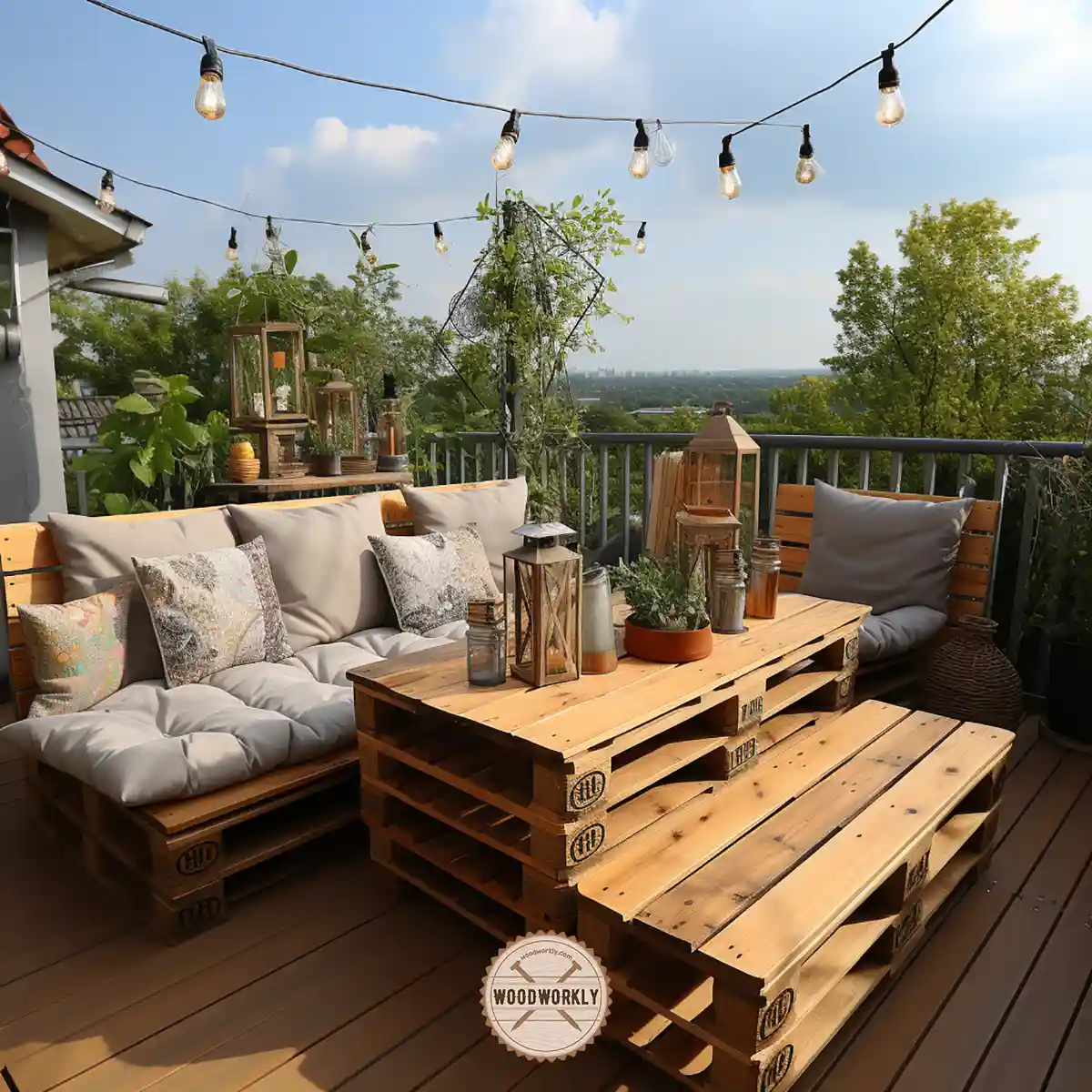
5. Staining Pallet Wood
Stain is able to protect pallet wood from UV light, water damage, insect attacks, scratches, and dents.
Plus, wood stain helps to give pallet woods any color you want with an attractive appearance.
You can mix wood stains before treating on pallet wood to get customized colors and most hardwood pallet wood stains so well.
If your pallet wood doesn’t stain well, better to apply wood conditioner first to control absorption speed.
With the use of a wood conditioner, you’ll be able to apply wood stain on any pallet wood without making any wood stain mistakes like blotches and streaks.
Now you have a clear idea about the best products that can use for treating pallet wood for outdoor use.
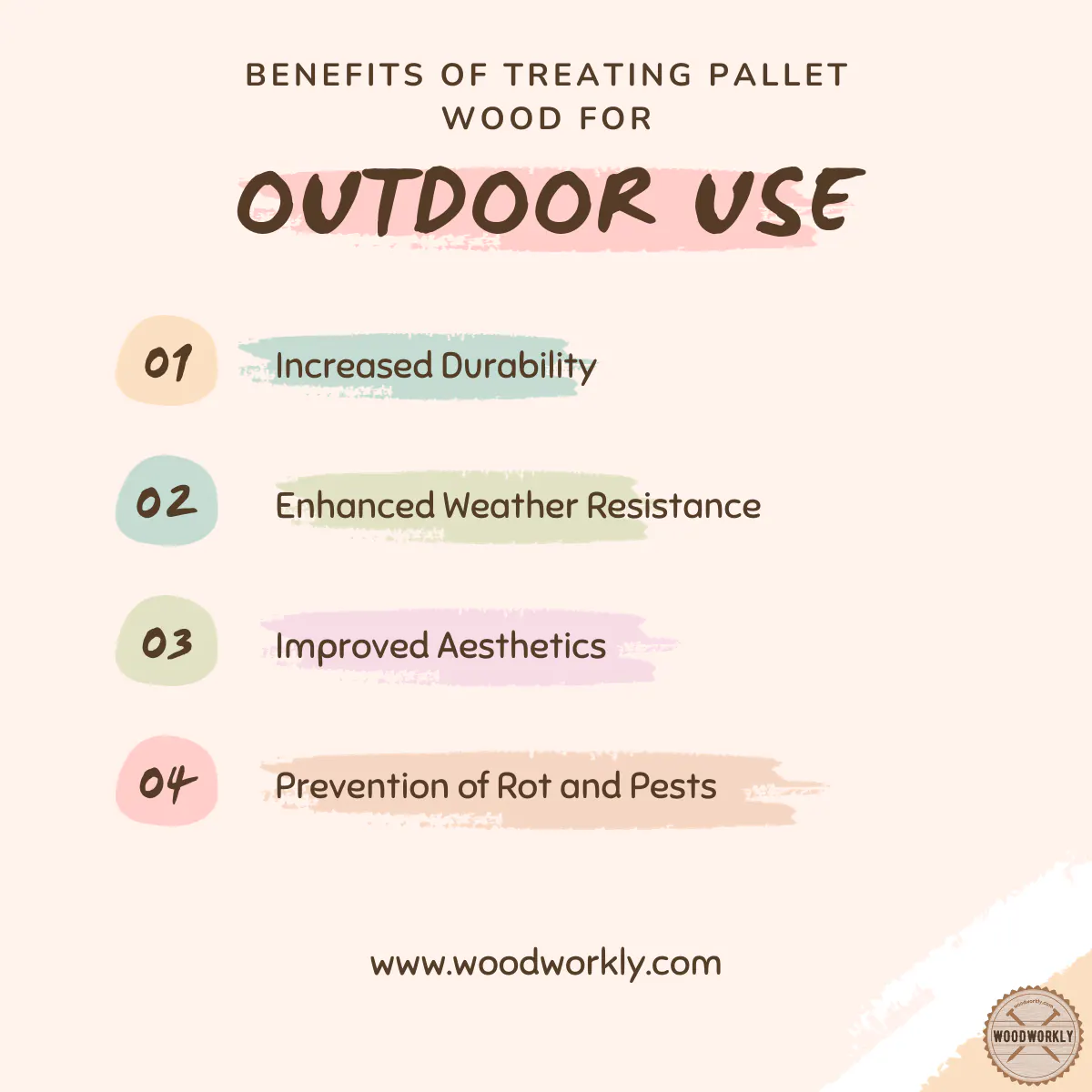
Let’s see how the treatment process should be done correctly.
How To Treat Pallet Wood for Outdoor Use?
Treating pallet wood for outdoor use is important to keep them protected from environmental elements, such as moisture, UV light, insect attacks, and harsh weather conditions.
Treating pallet wood will also help to improve their sheen by giving an attractive look to outdoor pallet furniture and woodwork.
Here’s the process of treating pallet wood for outdoor use,
- Select a safe pallet
- Clean and prepare the surface
- Sand the entire surface
- Treat the pallet
- Let the finish dry and cure
So, let’s discuss each of the above steps one by one to see how to treat pallet woods correctly for outdoor use.
1. Select a Safe Pallet
Before treating you need to have a good understanding of where pallet woods came from since they use in different industries.
Some of them can be so harmful and not in a good condition to be treated.
Some pallet woods were placed next to the trash cans and grew mold and habitat for rats and cockroaches. So, never use that kind of pallet wood for outdoor furniture even after treatment.
Get pallets from local used pallet dealers by knowing where they came from and how were they used.
Check if your pallets are marked with the letters “MB” stamped on them. MB means Methyl Bromide which is a harmful chemical.
That means Methyl Bromide has been used on your pallets as a pesticide.
Those MB-stamped pallets should not be used as outdoor furniture since they can be toxic to humans.
Check whether your pallets have stain rings that occurred due to chemicals.
Better to avoid those pallets for outdoor furniture since they can contain toxic chemical compounds even after treating the wood.
Follow the below table before treating any kind of pallet wood.
| Code In Pallet | Treatable or not |
|---|---|
| IPPC Logo | Not Sure |
| DB | Safe to treat |
| HT | Safe to treat |
| MB | Do not treat and use |
| EPAL | Safe to treat |
| EUR | Do not treat |
| Colored Pallet | Do not treat or use |
In summary, here’s how you should select a safe pallet for treatment,
- IPPC logo stamped pallets came from abroad and not sure whether they are safe to treat or not.
- DB stamped pallets (Debarked) are chemically free and safe to treat.
- HT stamped pallets (Heat treated) repel bugs without chemical treatments and are safe to treat.
- MB stamped pallets (Methyl Bromide) do not treat due to high toxicity.
- EPAL stamped pallets (European Pallet Association Logo) are debarked or heat treated and safe to treat.
- EUR stamped pallets are the old versions of EPAL and do not treat without the EPAL logo.
- Colored pallets are toxic and do not treat or used for outdoor projects.
DB, HT, and EPAL stamped pallet woods are good for treating. So, better to use only those pallet woods for outdoor woodworking projects.
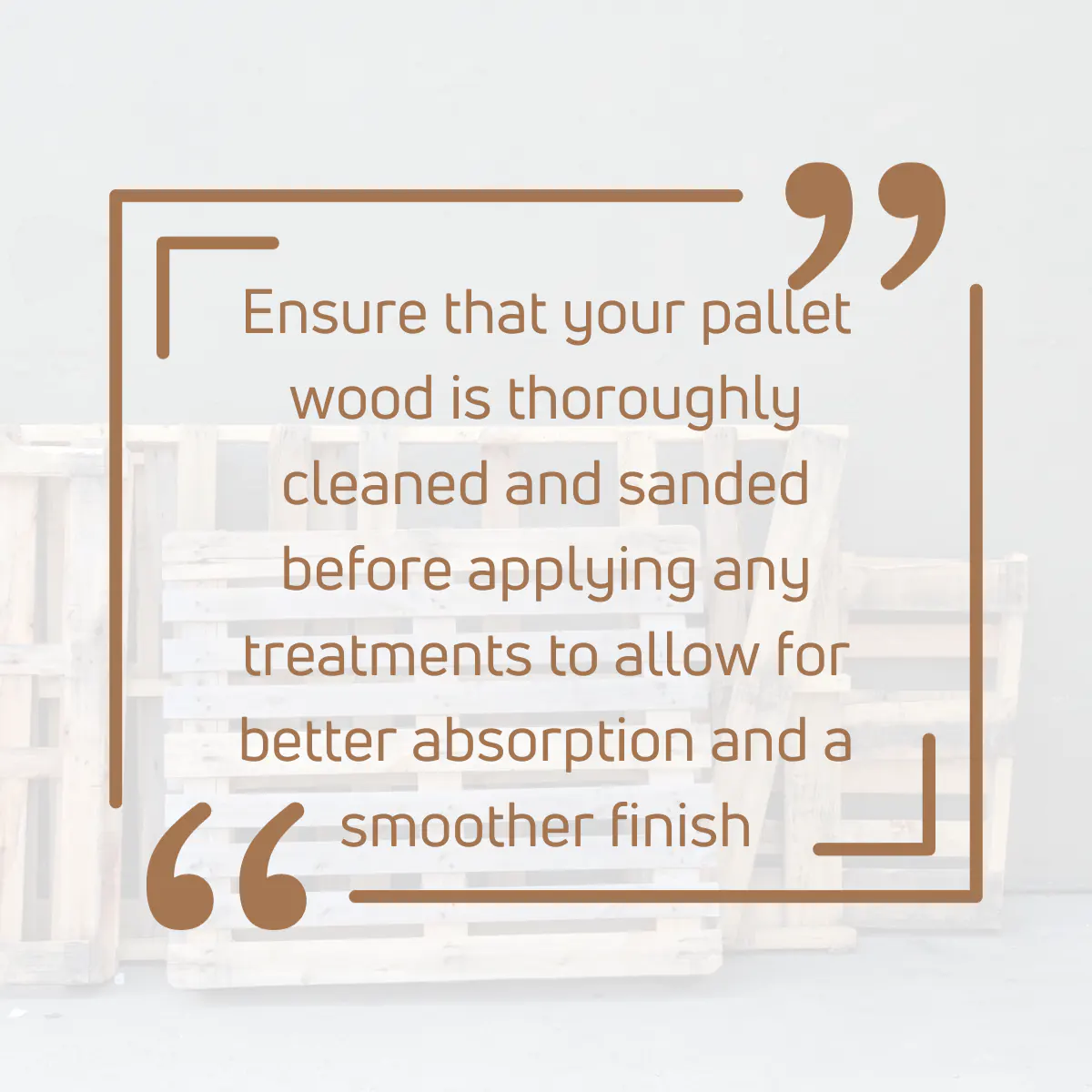
2. Clean and Prepare the Surface
After selecting a safe pallet for treating before outdoor use, clean the entire wooden surface using a pressure washer.
Before treating you need to remove all the dust, dirt, grease, stain marks, and all other impurities from the pallet wood surface for better absorption of the treating compound.
Cleaning helps to treat pallet woods without making any mistakes and increases the durability of the wood.
After cleaning the wood properly, let it dry completely before moving to the next step.
3. Sand The Entire Surface
Once the pallet wood is completely dried, sand the entire surface with 220 grit sandpapers to eliminate surface randomness and make the surface ready to take the treating product.
Sand along the direction of the wood grain for better treatment and it helps to make the surface even and smooth.
After sanding, the pallet wood surface is easy to finish, and the coat has less tendency to crack or peel.
If your pallet wood has protruding nails, and screw heads, better to remove them before sanding to prevent your grinding tools from getting damaged.
Once you’re done with sanding, remove sawdust using a dust pipe or rag and prepare the surface for treating.
4. Treat The Pallet Wood
Now you can treat the pallet wood surface with epoxy finish, oil finish, paint, varnish, or stain. Apply the treating product along the direction of the wood grain for better absorbance.
Let the coats dry between coats.
Apply 2 – 3 coats to treat pallet wood for any kind of outdoor woodworking project.
Make sure to treat the pallet all over the surface without missing any spots. Use a paintbrush when treating.
If you’re using stain to treat pallet wood, better to apply wood conditioner first to control wood absorption rates and to avoid making wood stain mistakes.
Treat pallet woods in a well-ventilated area for proper drying and to avoid breathing harmful chemicals.
Once pallet woods are well treated, they are waterproof, UV resistant, and do not rot easily for a few years.
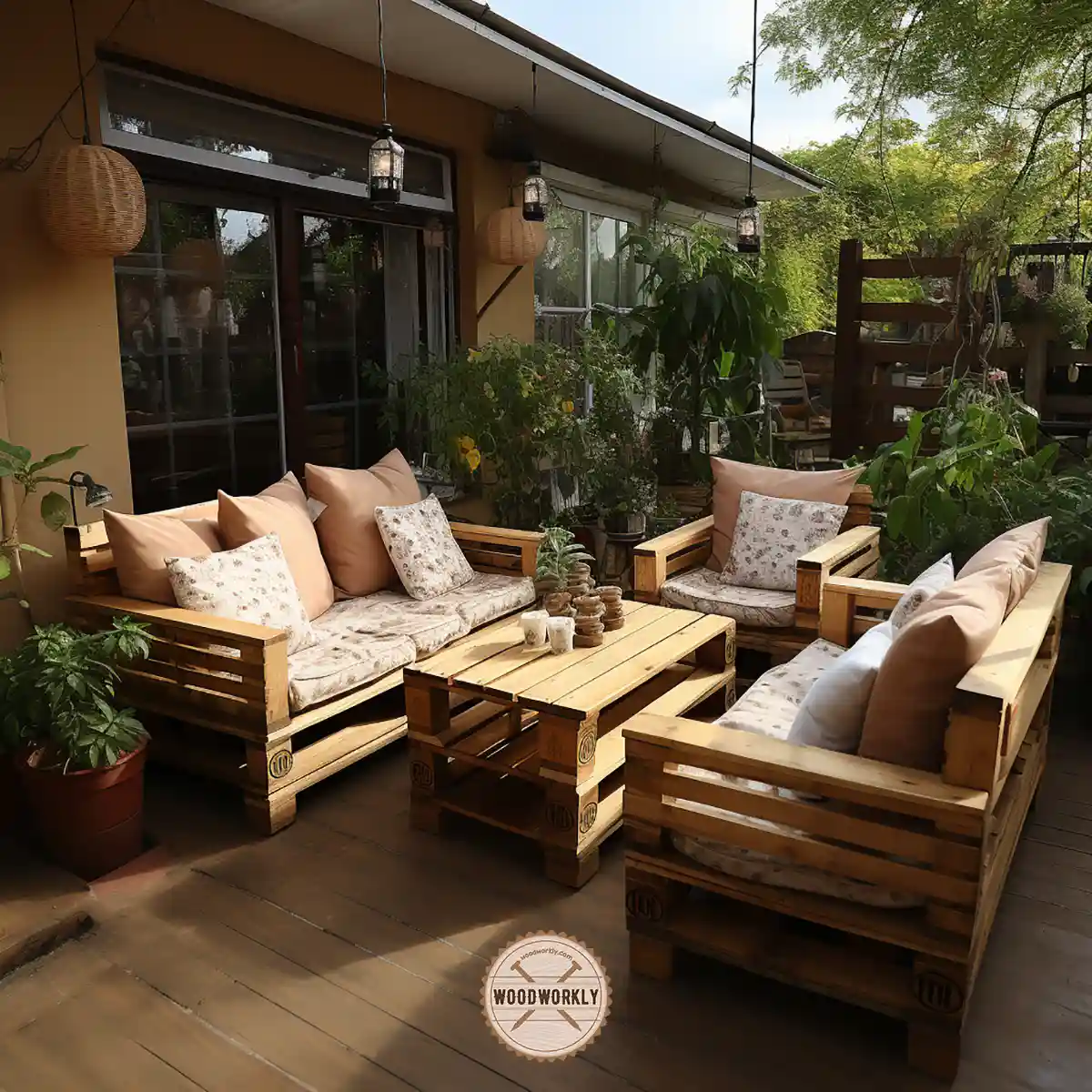
5. Let The Finish Dry and Cure
After treating pallet wood, let the finish dry and cure completely before using it for outdoor use.
Let treated coats dry and settle for at least 48 hours.
Curing time can be 2 – 3 days which varies on the treated product type and environmental humidity.
If you live in a humid area, this can take even more than a week. However proper drying and treating are a must to get a good protective coat over the wooden surface.
After drying and curing pallet wood will get its new look and now you can use it as outdoor furniture or woodwork since it has a good protective shield against environmental elements such as moisture, UV light, insect attacks, and more.
Drying and curing are essential for excellent treatment.
Read to know how to protect any wood from outdoor elements.
That’s it, Folks! Now you know how to treat pallet wood for outdoor use with simple treating steps.
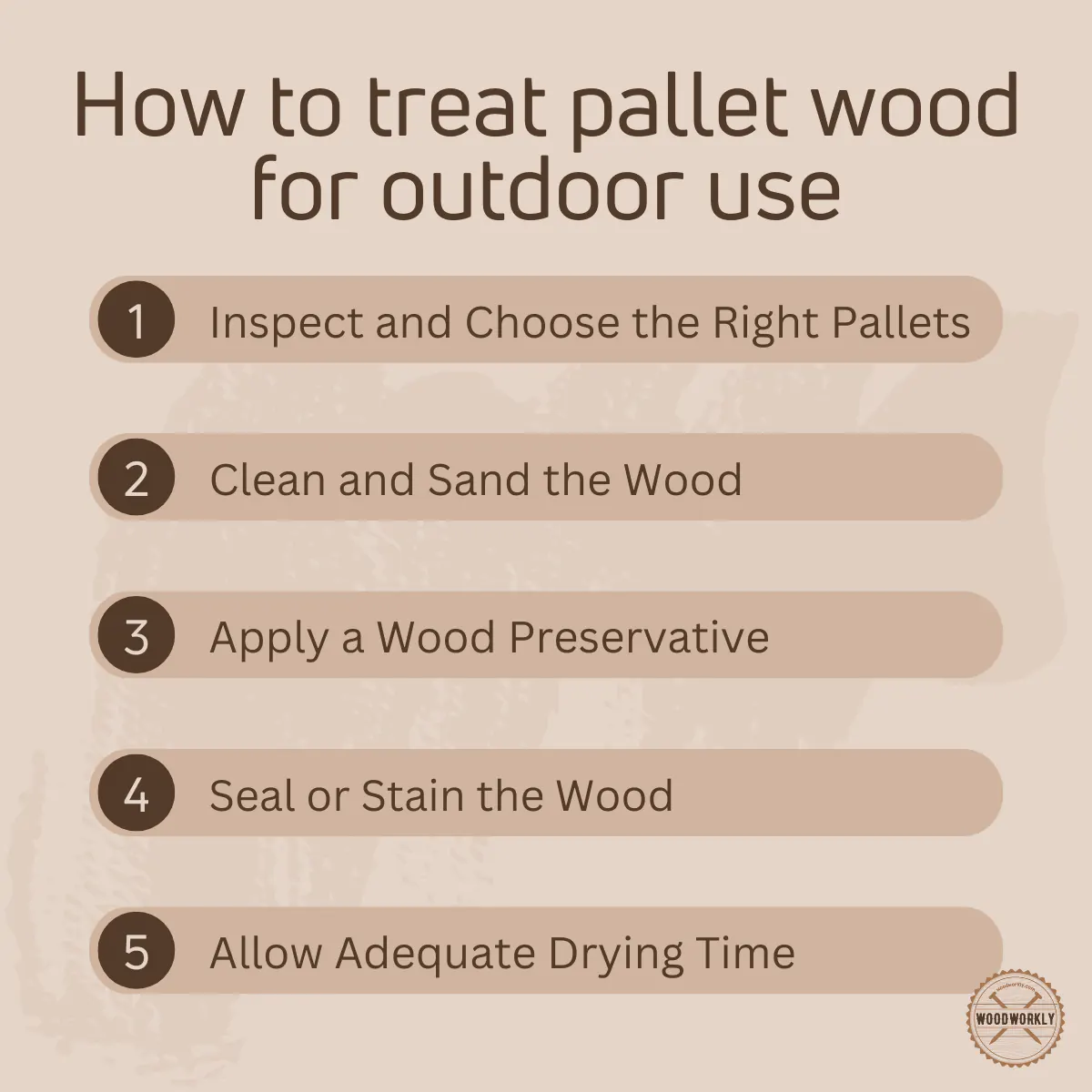
Can Pallets Be Used for Outdoor Furniture?
Pallets can be used for outdoor furniture only if they have DB or HT or EPAL stamped codes.
MB stamped pallets are not good for outdoor furniture due to toxicity.
Here are some popular outdoor furniture that can be made using pallets,
- Porches
- Patio Furniture
- Flower boxes
- Planters
- Wooden fences
- Outdoor tables
- Outdoor chairs
- Garden beds
As you can see pallets can be used literally for any outdoor furniture only if they are safe to use.
How Long Will Pallet Wood Last Outside?
Without proper treatment, pallet wood will last only a few months on the outside. But after proper treatment, pallet wood will last 2 -3 years outside with being waterproof and UV resistant.
Bare pallet wood will get easily attacked by moisture and start wood rotting.
Plus, molds will grow and won’t last much longer under harsh weather conditions.
Therefore, proper treatment is a must for pallet wood to last them for years with excellent protection from environmental elements like moisture, UV light, insect attacks, and more.
How To Treat Pallet Wood for Termites?
You can treat pallet wood for termites by applying a borate preservative solution to the wood.
It will repel bugs, insects, and termites and make pallet wood protected from termites’ attacks.
Here are the steps you need to follow when treating pallet wood for termites,
- Clean and sand the wood.
- Cover the work area and ventilate the space.
- Prepare borate preservative solution by mixing borate preservative with water in a bucket and stirring well.
- Apply to prepare borate preservative solution on the entire pallet wood surface evenly.
- Let the wood dry for 4 hours.
- Apply another coat of borate preservative solution and let it dry.
- Apply water repellant finish on dried pallet wood along the wood grain using a paint brush.
- Let the surface dry and cure.
After treating as above process, your pallet wood will be termites-free.
But never use bromide-treated pallet wood as tables or chairs that contact human skin since they are extremely harmful.
How to Weatherproof Pallet Wood?
Weatherproofing pallet wood is crucial when it’s intended for outdoor use.
Without proper treatment, the wood is susceptible to the elements, which can lead to decay, warping, and discoloration.
Below is a comprehensive guide on how to ensure that your pallet wood stands up to the weather and lasts for years.
1. Choosing the Right Pallets:
Before you start, make sure you are using pallets that are safe and free from harmful chemicals.
Look for pallets marked with “HT,” which means they have been heat-treated rather than chemically treated.
2. Cleaning the Wood:
Begin by cleaning the pallets. Remove any nails, staples, or other metal pieces, and sand the wood down to remove any splinters or rough spots.
3. Applying a Weatherproof Finish:
There are several options for weatherproof finishes, and the right one for you depends on your project and preference.
a. Oil Finishes:
Oil finishes such as tung oil, linseed oil, and hemp oil penetrate deep into the wood, providing a durable protection layer.
These natural oils help to repel water and can protect the wood from decay. However, they may require more frequent reapplication compared to other finishes.
b. Paint:
Paint provides a protective layer on the wood’s surface, shielding it from moisture and UV rays.
For best results, use exterior-grade paint and apply multiple coats. Ensure the paint is suitable for use on wood and is designed to withstand outdoor conditions.
c. Marine Spar Varnish:
Marine spar varnish is designed for wood exposed to harsh outdoor conditions, providing excellent protection against water, UV radiation, and chemicals.
It is ideal for pallet projects like outdoor furniture, fences, or decking. Ensure you apply several coats for maximum protection.
d. Epoxy Finish:
An epoxy finish creates a solid, protective layer on the wood, offering excellent resistance to water.
Mix the two-part epoxy (resin and hardener) according to the manufacturer’s instructions and apply it evenly to the wood.
Note that epoxy alone does not protect against UV radiation, so you may need to add a UV-resistant top coat like marine spar varnish.
4. Regular Maintenance:
To ensure longevity, regularly inspect your weatherproofed pallet wood for signs of wear and tear.
Reapply the finish as needed, especially if the wood starts to look dry or loses its sheen.
5. Additional Considerations:
- Avoid direct exposure to sunlight as much as possible, as UV rays can degrade the wood over time.
- Ensure proper drainage to prevent standing water, which can lead to wood rot.
- Be mindful of the environmental impact of your chosen finish, especially if using the pallet wood in a garden setting.
By following these steps, you can effectively weatherproof your pallet wood, ensuring that it remains durable and aesthetically pleasing for years to come.
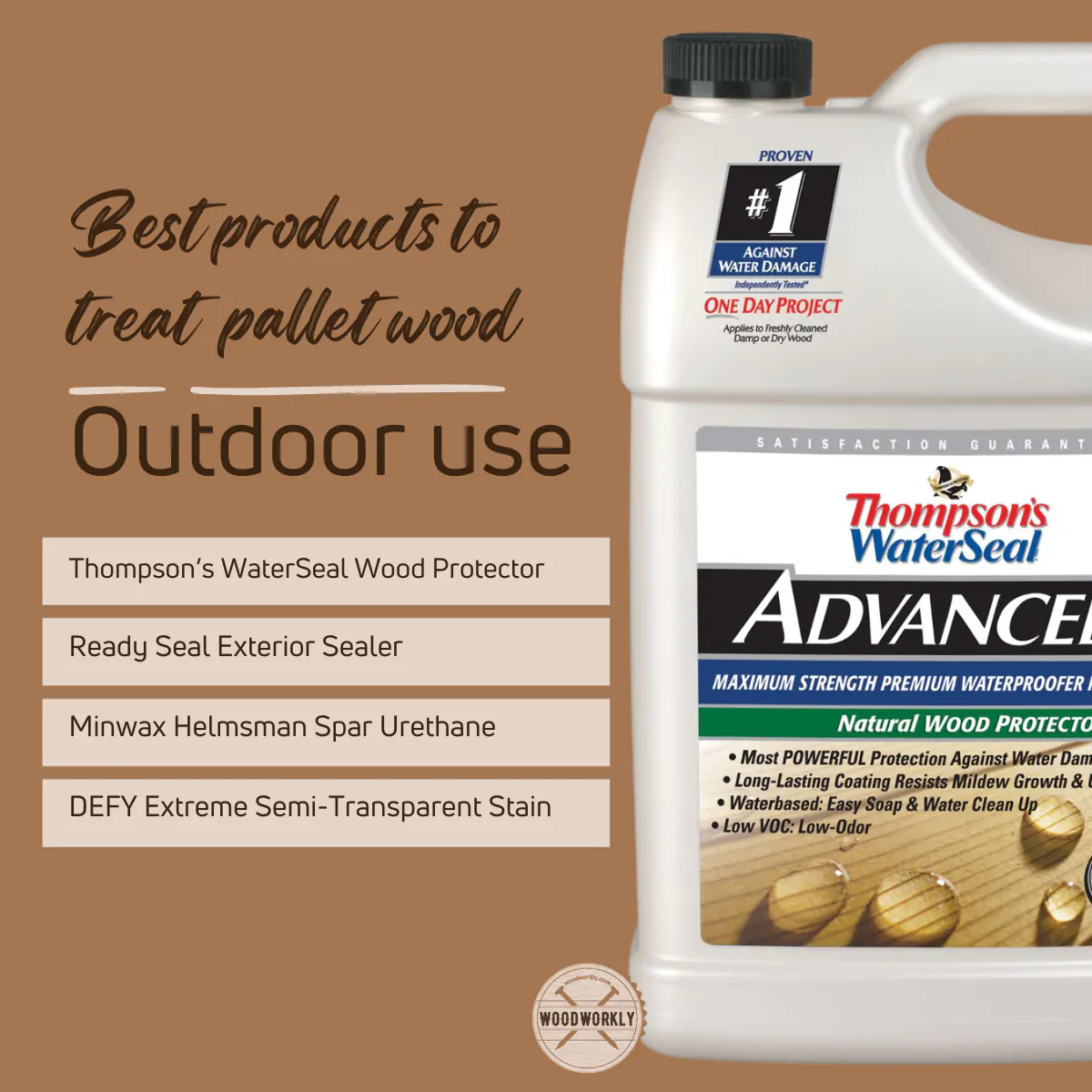
How to Keep Pallet Wood from Rotting
Preserving pallet wood is essential, especially when it’s intended for outdoor use, where it’s susceptible to moisture, insects, and decay.
Rot can quickly deteriorate wood, compromising its structural integrity and aesthetic appeal. Below is a detailed guide on how to keep your pallet wood from rotting.
1. Choose the Right Pallets:
Opt for pallets that are in good condition, free from signs of rot or damage.
Look for pallets marked with “HT” (heat-treated), as they are safer and more resistant to rot compared to chemically treated pallets.
2. Keep the Wood Dry:
Moisture is the primary cause of wood rot. Ensure that your pallets are stored in a dry location, away from direct contact with the ground.
Elevate them on blocks or use a tarp to protect them from rain and ground moisture.
3. Proper Ventilation:
Ensure that the pallets are well-ventilated. When stacking pallets, leave space between them to allow air to circulate, which helps in keeping the wood dry.
4. Apply a Wood Preservative:
Use a wood preservative that provides protection against rot and insect damage.
Products containing copper compounds, such as copper azole or alkaline copper quaternary (ACQ), are commonly used for this purpose.
Ensure that you follow the manufacturer’s instructions when applying the preservative.
5. Regular Inspection:
Regularly inspect the pallet wood for signs of rot or insect damage. Early detection allows you to address the issue before it spreads.
Look for discolored, soft, or crumbling wood.
6. Repair or Replace Damaged Wood:
If you find any damaged or rotting sections, repair or replace them promptly to prevent the rot from spreading.
7. Use a Waterproof Sealant:
Applying a waterproof sealant helps in protecting the wood from moisture.
Products like polyurethane or a water-repellent wood sealer provide a protective layer on the surface of the wood.
8. Elevate Outdoor Projects:
If using pallet wood for outdoor projects, such as decking or furniture, ensure that the wood is elevated off the ground to prevent moisture absorption from the ground.
9. Ensure Proper Drainage:
For pallet projects that are exposed to the elements, ensure that there is proper drainage to prevent water from pooling around the wood.
10. Avoid Direct Soil Contact:
If using pallet wood for gardening projects, avoid direct contact with soil, as it can retain moisture and harbor wood-rotting fungi.
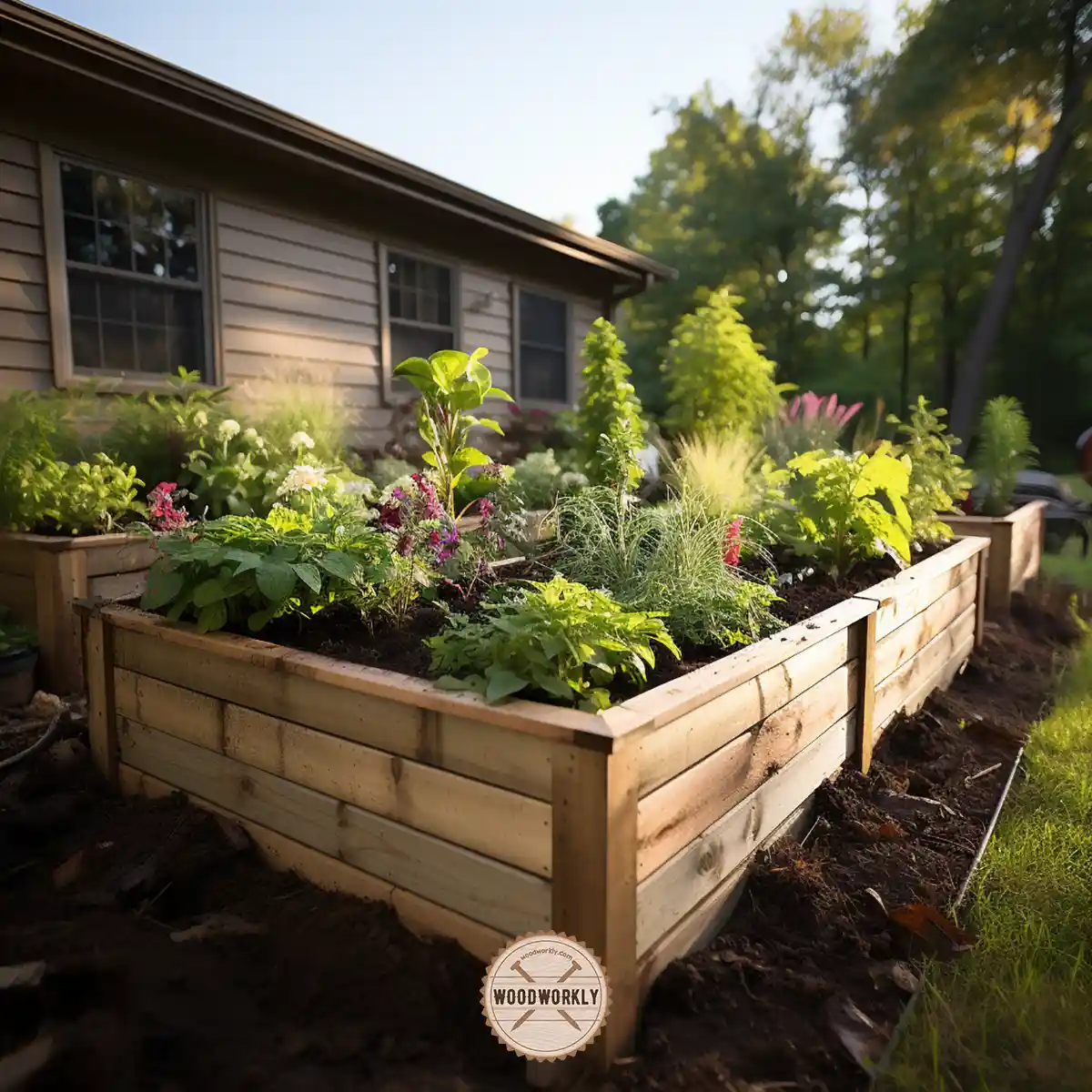
So, let’s answer some frequently asked questions about treating pallet wood.
FAQs
How do I choose the right pallets for outdoor use?
Look for pallets that are marked with “HT” indicating they are heat-treated, rather than chemically treated, and make sure they are in good condition without any signs of rot or damage.
What is the best way to protect pallet wood from moisture?
Keep the pallet wood dry by storing it in a dry location, away from direct contact with the ground, and apply a waterproof sealant to create a protective layer on the surface of the wood.
How can I prevent pallet wood from rotting?
Apply a wood preservative that protects against rot and insect damage, ensure proper ventilation and drainage, and avoid direct soil contact to prevent moisture accumulation.
Do I need to apply a finish to pallet wood used outdoors?
Yes, applying a finish like polyurethane or a water-repellent wood sealer will help protect the pallet wood from the elements and extend its lifespan.
How often should I inspect pallet wood used in outdoor projects?
Regularly inspect the pallet wood for signs of rot, insect damage, or other issues, and address any problems promptly to prevent further damage.
Can I use pallet wood for gardening projects?
Yes, but ensure that the pallet wood does not come into direct contact with soil and consider applying a wood preservative to protect against rot and decay.
Is it necessary to elevate pallet wood used for outdoor furniture or decking?
Yes, elevating pallet wood off the ground helps prevent moisture absorption from the ground, reducing the risk of rot and decay.
How do I ensure proper drainage for outdoor pallet projects?
Design your pallet projects to prevent water pooling, and consider adding drainage solutions if necessary to ensure water does not accumulate around the wood.
What should I do if I find rotting or damaged sections in my pallet wood?
Repair or replace the affected sections promptly to prevent the rot from spreading and compromising the integrity of the pallet wood.
Can I leave pallet wood untreated if it’s going to be used outdoors?
Leaving pallet wood untreated increases the risk of rot, decay, and damage from the elements, so it is recommended to apply a wood preservative and waterproof sealant to protect the wood.
Did I cover all you wanted to know about: How to Treat Pallet Wood For Outdoor Use?
In this article, I have deeply discussed how to treat pallet wood for outdoor use and what types of finishes we can use to treat pallets with their pros and cons.
You can treat pallet wood for outdoor use by cleaning the wood, sanding the entire surface, applying oil finish, epoxy finish, paint, varnish, or stain on the surface, and letting the finish dry and cure before use. Treated pallet woods are waterproof and UV resistant with an enhanced wood appearance.
Furthermore, I’ve answered some frequently asked questions regarding how to treat pallet wood for outdoor use as well.
Hope you have gained good knowledge about treating pallet wood for outdoor projects.
Make sure to try things you have learned from this post for your next pallet wood outdoor project. Keep practicing!